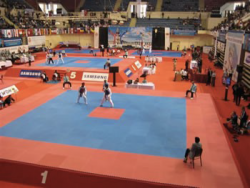Refereeing at competitions
Refereeing at competitions
You from yellow belt already learned something about the rules, we will proceed in how arbitration works going on competitions.
Referees are both women and men. This is how it is going.
Sparring
How and what?
A fight usually lasts 2 minutes and is decided by points. If there is a tie after the 2 minute another 1 minute fight is foreseen. If after that minute there is still no winner, then there is a golden point.
If fight is in the pointstop system, winner is decided by the first point scorring.
Who?
Participants are devided into: chong (blue) and hong (red).
Corner referees: scoring the points. You score a point when one or more (corner referee) saw it.
Center Referee: leading the fight. He starts and stops the fight. He is the person who (center referee) fight interrupts for giving warnings.
The jury table: The table has the Jury President, and is responsible for the ring. He keeps track of which participants have to come one after another. Also, there is A jury member who maintains the warnings for the later check Judges. The Timekeeper watching time during fight. There is one center referee present at the table as a reserve.
Points
Items are listed on the points form. After the fight the central umpire receives the corner referee points on a form. Afterwards he brings the forms to the table. Since everything is counted, then the result is communicated by the jury president who then names the winner.
In sparring, the points are allocated as here below :
- 1 point for all fist techniques on the body or face
- 2 points for all leg techniques on the body
- 3 points for all leg techniques on the face
Warnings:
- Ui Ju Hanna: before a warning is given, the fight is stopped (= heachyo) and then a warning is attributed to the accused person. After three warnings, one point is deducted.
- Gam Jum Hanna: you can get a minus point through full contact (too hard, usually uncontrolled), falling down or ignoring umpire commands. Three direct minus points means disqualification (Sil Kyuk).
You get a warning by :
- Pushing
- Kicking below the belt
- Grabbing opponent
- Performing a technique on the back
- Deliberately avoiding battle (running away)
- Falling down (touch by hand on ground)
- Going out of the ring
- Attacking without looking
- turning away
- talking
- Claiming provoking point
Back to top of page - Back to Welcome Page
Tuls
How and what?
The higher the grade, the more one walks on tuls competition. With colored belts is usually only one tul performed.
Who?
There are five judges who assess the Tul. There is still the table with the referee.
Points
The jury always takes into account several factors, including:
- strength
- balance
- breathing
- technique
- rhythm.
There are two systems used in Tul, namely points or waste system.
The five referees have the duty to designate a winner or a tie. The majority of these five is the winner.
- Example 2 votes for hong and 3 for chong, chong = win.
In the point system, each referee scores points separately.
Separate points are given according to different factors. Maximum 5 points for technique and maximum 3 for strength, balance, breathing or rhythm each. One gets a final score with a maximum value of 17.
Team sparring
In team sparring there are five people per team. There is a toss, the winner decides which team chooses the person to bring forward. Point are given as :
- 1 point for a tie
- 2 points for are winning
The team with the most points wins.
Team Tul
Here the same rules apply like in Tul. Can be made using waste system (taking turns walking or tul) or the points system.
A team consists of 3 to 5 people. When the points are returned separately, points are given according to the different factors as in Tul.
There will be one additional factor, namely a maximum of 5 points for presentation, team work and choreography. So a maximum value of 22 points.
Special technics
In this discipline are so high, or run as far as possible stages. Depending on each discipline. a few examples:
- Tymio nopi ap cha busigi
- Tymio nomo yop cha jirugi
- Tymio dollyo chagi
- ...
It is usually a knockout and one goes further or higher until there is a winner. On the big leagues a point is used and there to perform various steps.
Power breaking
Here we try to break a hand or foot technique as many boards. Also, waste or points system. Some techniques:
- Ap jumok jirugi
- Yop cha jirugi
- Bandae dollyo chagi
- ...
Traditional sparring
Here a style battle is performed. It has few limits, fully rehearsed by the pair. The referees determine the two winners on several factors. The different duos come taking turns in ring "style sparring.
